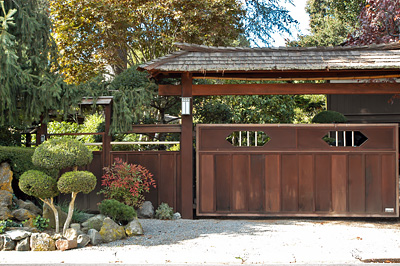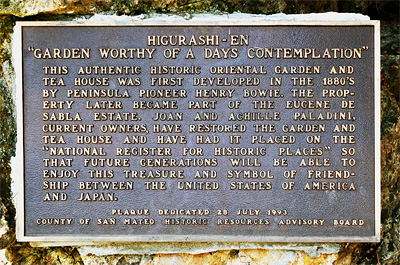National Register of Historic Places in San Mateo County

 26 October 2004
26 October 2004
(Click Photos to Enlarge)
Higurashi-en
"Garden Worthy of a Days Contemplation"
This authentic historic oriental garden and tea house was first developed in the 1880's by Peninsula pioneer Henry Bowie. The property later became part of the Eugene de Sabla estate. Joan and Achille Paladini, current owners have restored the garden and tea house and have had it placed on the "National Register for Historic Places" so that future generations will be able to enjoy this treasure and symbol of friendship between the United States of America and Japan.
De Sabla Teahouse and Tea Garden
70 De Sabla Avenue
San Mateo
Built c1907
In 1853, William Davis Merry Howard, a San Mateo merchant, purchased this part of the San Mateo Rancho. The grounds were groomed by John McLaren, who subsequently became become Superintendent of Golden Gate Park.
Between 1870 and 1920, wealthy San Franciscans transformed the grassland and farms of the San Francisco peninsula into large estates with landscaped gardens. Eugene de Sabla, a major industrialist and a founder of Pacific Gas and Electric Company, purchased the Howard estate and named it El Cerrito. After World War II, most of the estates were demolished and the land subdivided for housing. The de Sabla teahouse and garden, surrounded by suburban development, are survivors.
The teahouse and garden are the work of Asian landscape designer Makota Hagiwara, the chief gardener and concessionaire of the Japanese Tea Garden in Golden Gate Park. The tea garden is the only other known extant example of his work and the only surviving private Japanese tea garden of the many that existed on the grand estates.
At the beginning of the 20th century, Japanese architecture and landscape influenced the development of Craftsman style architecture in California. The simple wood construction and Japanese joinery methods of the teahouse and controlled traditional and labor intensive design of the garden were exemplified the principles of the Arts and Crafts movement.
Source: NRHP nomination.

While wealthy white men were transforming the peninsula, the first Japanese immigrants trickled into San Francisco. Prior to 1880 there were fewer than two hundred Japanese residents in the San Francisco Bay Area. By 1889, there were almost two thousand.
In 1886, Japan opened up emigration, which had been suspended in 1868 because of poor treatment of Japanese workers by Hawaiian planters. The Emperor, who wanted to modernize and westernize Japan, encouraged Japanese to go abroad. Laborers from impoverished farming areas were also attracted to California. Many replaced laborers in the United States excluded by the 1888 Chinese Exclusion Act.
Source: NRHP nomination.
